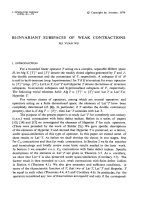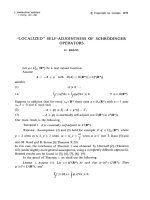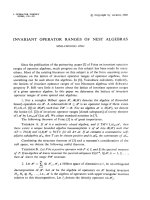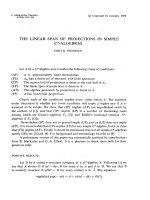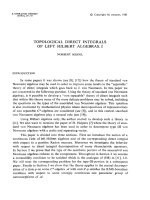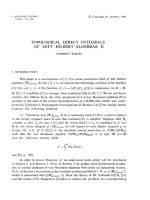Báo cáo toán học: "Regular spanning subgraphs of bipartite graphs of high minimum degree" docx
Bạn đang xem bản rút gọn của tài liệu. Xem và tải ngay bản đầy đủ của tài liệu tại đây (108.44 KB, 7 trang )
Regular spanning subgraphs of bipartite
graphs of high minimum degree
B´ela Csaba
∗†
Submitted: Aug 1, 2007; Accepted: Oct 5, 2007; Published: Oct 16, 2007
Mathematics Subject Classification: 05C70
Abstract
Let G be a simple balanced bipartite graph on 2n vertices, δ = δ(G)/n, and
ρ
0
=
δ+
√
2δ−1
2
. If δ ≥ 1/2 then G has a ρ
0
n-regular spanning subgraph. The
statement is nearly tight.
1 Introduction
In this paper we will consider regular spanning subgraphs of simple graphs. We mostly
use standard graph theory notation: V (G) and E(G) will denote the vertex and the edge
set of a graph G, respectively. The degree of x ∈ V (G) is denoted by deg
G
(x) (we may
omit the subscript), δ(G) is the minimum degree of G. We call a bipartite graph G(A, B)
with color classes A and B balanced if |A| = |B|. For X, Y ⊂ V (G) we denote the number
of edges of G having one endpoint in X and the other endpoint in Y by e(X, Y ). If
T ⊂ V (G) then G|
T
denotes the subgraph we get after deleting every vertex of V −T and
the edges incident to them. Finally, K
r,s
is the complete bipartite graph on color classes
of size r and s for two positive integers r and s.
If f : V (H) → Z
+
is a function, then an f-factor is a subgraph H
of the graph H
such that deg
H
(x) = f(x) for every x ∈ V (H). Notice, that when f ≡ r for some r ∈ Z
+
,
then H
is an r-regular subgraph of H.
There are several results concerning f -factors of graphs. Perhaps the most notable
among them is the theorem of Tutte [7]. Finding f-factors is in general not an easy task
even for the case f is a constant and the graph is regular (see eg., [1]). In this paper we
look for f -factors in (not necessarily regular) bipartite graphs with large minimum degree,
for f ≡ r.
∗
Analysis and Stochastics Research Group of the Hungarian Academy of Sciences, University of Szeged,
Hungary and Department of Mathematics, Western Kentucky University, Bowling Green, KY, USA
†
Partially supported by OTKA T049398 and by Hungarian State E¨otv¨os Fellowship.
the electronic journal of combinatorics 14 (2007), #N21 1
Theorem 1 Let G(A, B) be a balanced bipartite graph on 2n vertices, and assume that
δ = δ(G)/n ≥ 1/2. Set ρ
0
=
δ+
√
2δ−1
2
. Then
(I) G has a ρ
0
n–regular spanning subgraph;
(II) moreover, for every δ > 1/2 if n is sufficiently large and δn is an integer then there
exists a balanced bipartite graph G
δ
having minimum degree δ such that it does not admit
a spanning regular subgraph of degree larger than ρ
0
n.
The above theorem plays a crucial role in the proof of some results in extremal graph
theory ([2, 3]).
2 The main tool
Let F be a bipartite graph with color classes A and B. By the well-known K¨onig–Hall
theorem there is a perfect matching in F if and only if |N(S)| ≥ |S| for every S ⊂ A. We
are going to need a far reaching generalization of this result, due to Gale and Ryser [6, 4]
(one can find the proof in [5] as well). It gives a necessary and sufficient condition for the
existence of an f -factor in a bipartite graph:
Proposition 2 Let F be a bipartite graph with bipartition {A, B}, and f(x) ≥ 0 an
integer valued function on A ∪ B. F has an f–factor if and only if
(i)
x∈A
f(x) =
y∈B
f(y)
and
(ii)
x∈X
f(x) ≤ e(X, Y ) +
y∈B−Y
f(y)
for all X ⊂ A and Y ⊂ B.
3 Proof of Theorem 1
We will show the two parts of the theorem in separate subsections.
3.1 Proof of part I
Observe, that since we are looking for a spanning regular subgraph, the f function of
Proposition 2 will be identically ρn for some constant ρ. We start with some notation:
for X ⊂ A let ξ = |X|/n, and for Y ⊂ B let σ = |Y |/n. We will normalize e(X, Y ):
η(X, Y ) = e(X, Y )/n
2
. Let
η
m
(ξ, σ) = min{η(X, Y ) : X ⊂ A, Y ⊂ B, |X|/n = ξ, |Y |/n = σ}.
the electronic journal of combinatorics 14 (2007), #N21 2
Since f is identically ρn, condition (i) of Proposition 2 is satisfied. Moreover, if ρn is
an integer and
ρ(ξ + σ − 1) ≤ η
m
(ξ, σ)
for some ρ and for every 0 ≤ ξ, σ ≤ 1, then (ii) is satisfied, hence, G has a ρn–regular
spanning subgraph. In the rest of this section we will show that the above inequality is
valid for ρ = ρ
0
n/n.
Clearly, e(X, Y ) ≥ |X|(δn − |B − Y |) and e(X, Y ) ≥ |Y |(δn − |A − X|) for arbitrary
sets X ⊂ A and Y ⊂ B. Hence, we have that η
m
(ξ, σ) ≥ max (ξ(δ + σ − 1), σ(δ + ξ − 1)).
(In fact we always have that η
m
≥ 0, since it is the edge density between the two color
classes in G.)
First consider the case ξ = σ. We are looking for a ρ for which ρ(2ξ −1) ≤ ξ(δ +ξ −1).
In another form, we need that
p
ρ
(ξ) = ξ
2
+ (δ − 2ρ −1)ξ + ρ ≥ 0.
The discriminant of the above polynomial is the polynomial dcr(ρ) = 4ρ
2
−4δρ +δ
2
−
2δ + 1. Clearly, if dcr(ρ) ≤ 0 for some ρ, then p
ρ
(ξ) ≥ 0.
One can directly find the roots of dcr(ρ):
δ±
√
2δ−1
2
. At this point we have to be careful,
since the degrees in a graph are non-negative integers, so ρn has to be a natural number.
We will show that dcr(ρ) ≤ 0 for ρ = (δ +
√
2δ − 1)n/2/n.
Clearly, dcr(x) ≤ 0 in I = [(δ −
√
2δ − 1)/2, (δ +
√
2δ − 1)/2], the length of this
interval is
√
2δ − 1. Divide the [0, 1] interval into n disjoint subintervals each of length
1/n, denote the set of the endpoints of these subintervals by S. Observe that is I ∩S ≥ 1,
then we can pick the largest point of this intersection, this is ρ ∈ I, and we are done with
proving that p
ρ
(ξ) ≥ 0.
We will investigate two cases: first, if δ > 1/2, and second, if δ = 1/2.
First case: δ > 1/2. We know that δn is an integer, it is larger than n/2, hence,
δn ≥
n+1
2
. If the length of I is at least 1/n, it will intersect with S. Assuming that
√
2δ − 1 <
1
n
we would get δn <
n
2
+1
2n
, but the latter expression is less than
n+1
2
. Hence,
in this case |I ∩ S| ≥ 1.
Let g(ξ, σ) = σ(δ+ξ−1)−ρ(ξ+σ−1). We will show, that g(ξ, σ) ≥ 0 for 0 ≤ σ ≤ ξ ≤ 1,
in the lower right triangle T of the unit square. This will prove that (ii) of Proposition 2
is satisfied. Notice, that g is bounded in the triangle above, −2 ≤ g(ξ, σ) ≤ η
m
(ξ, σ) −
ρ(ξ + σ − 1), and continously differentiable.
Let us check the sign of g on the border of the triangle. Since ρ = (δ+
√
2δ − 1)n/2/n,
we have that g(ξ, ξ) ≥ 0. g(ξ, 0) = −ρ(ξ − 1) ≥ 0, and g(1, σ) = σ(δ − ρ) ≥ 0, because
δ ≥ (δ +
√
2δ − 1)/2. Let us check the partial derivatives of g:
∂g
∂ξ
= σ − ρ,
and
∂g
∂σ
= δ + ξ −1 − ρ.
the electronic journal of combinatorics 14 (2007), #N21 3
Assuming that g achieves its minimum inside the triangle at the point (ξ
, σ
) the partial
derivatives of g have to diminish at (ξ
, σ
). It would then follow that σ
= ρ and ξ
=
1+ ρ −δ, therefore, g(ξ
, σ
) = ρ
2
−ρ(2ρ −δ) = δρ−ρ
2
. Hence g is non-negative in T . The
same reasoning works for the triangle 0 ≤ ξ ≤ σ ≤ 1, this follows easily by symmetry.
With this we finished the proof for the case δ > 1/2.
Second case: δ = 1/2. If δn is even (n is divisible by 4), we are done, since in this
case I contains the point δ/2 = n/4/n, and δn/2 is an integer. Therefore we have that
p
1/4
(ξ) ≥ 0, and as above, one can check that g is non-negative in every point of T .
There is only one case left: if δn is odd, that is, n is of the form 4k+2 for some natural
number k. In this case we want to prove, that that the spanning subgraph is
k
4k+2
-regular.
First observe, that for our purposes it is sufficient if g(ξ, σ) ≥ 0 in a discrete point set:
in the points (ξ, σ) belonging to (S ×S) ∩T , since |X| and |Y | are natural numbers. Set
ρ =
k
4k+2
and analyze the polynomial p
ρ
(ξ). It is an easy exercise to check that it has two
distinct roots: 1/2 =
2k+1
4k+2
and 1/2−1/n =
2k
4k+2
. Hence, p
ρ
(ξ) ≥ 0 for ξ ∈ (1/2−1/n, 1/2).
We will cut out a small open triangle T
s
from T . T
s
has vertices (1/2, 1/2), (1/2, 1/2−
1/n) and (1/2 − 1/n, 1/2 − 1/n). Clearly, T −T
s
is closed and T
s
∩ (S × S) = ∅.
Recall, that g(ξ, σ) = σ(δ + ξ − 1) − ρ(ξ + σ − 1) for 0 ≤ σ ≤ ξ ≤ 1. We will check
the sign of g on the border of T −T
s
. There are two line segments for which we cannot
apply our earlier results concerning g. The first is
L
1
=
(ξ, σ) :
n − 2
2n
≤ ξ ≤
1
2
, σ =
n − 2
2n
,
the second is
L
2
=
(ξ, σ) : ξ =
1
2
,
n − 2
2n
≤ σ ≤
1
2
.
On L
1
we get that
g
ξ,
n − 2
2n
=
n − 2
2n
ξ −
1
2
−
k
4k + 2
ξ −
n − 2
2n
=
k
n
ξ −
k
2n
+
k
n
2
.
It is easy to see that the above expression is non-negative for every (n−2)/(2n) ≤ ξ ≤ 1/2.
For L
2
we have
g
1
2
, σ
= σ
1
2
+
1
2
− 1
−
k
4k + 2
1
2
+ σ − 1
=
k
4k + 2
1
2
− σ
≥ 0
for (n − 2)/(2n) ≤ σ ≤ 1/2.
In order to finish proving that g is non-negative in every point of (S ×S)∩(T −T
s
) it is
sufficient to show that the minimum of g inside T −T
s
is at least as large as the minimum
of g on the border of T − T
s
. This can be shown along the same lines as previously. By
symmetry we will get that condition (ii) of Proposition 2 is satisfied in every point of
S × S.
the electronic journal of combinatorics 14 (2007), #N21 4
3.2 Proof of part II
For proving part II of the theorem we want to construct a class of balanced bipartite
graphs the elements of which cannot have a large regular spanning subgraph. We will
achieve this goal in two steps. First, we will consider a simple linear function, which, as
we will see later, is closely related to our task. In the second step we will construct those
bipartite graph which satisfy part II of Theorem 1.
Set γ
=
1−
√
2δ−1
2
and let 0 < p < 1. Consider the following equation:
(1 − p)(1 − γ
) = γ
(1 − p) + δ − γ
. (1)
It is easy to see that p
=
δ+γ
−1
2γ
−1
is its solution. We have that
(1 − p
)(1 − γ
) =
1 −
δ + γ
− 1
2γ
− 1
(1 − γ
) =
γ
− δ
2γ
− 1
(1 − γ
).
Substituting γ
=
1−
√
2δ−1
2
we get
δ −
1−
√
2δ−1
2
√
2δ − 1
1 −
1 −
√
2δ − 1
2
=
2δ − 1 +
√
2δ − 1
√
2δ − 1
1 +
√
2δ − 1
2
=
1 +
√
2δ − 1
2
1 +
√
2δ − 1
2
=
δ +
√
2δ − 1
2
.
We promised to define a class of bipartite graphs for δ > 1/2 which exist for every
sufficiently large value of n if δn is a natural number, such that these graphs do not admit
spanning regular graphs with large degree.
For that let γ = γ
n/n. Then γn is an integer, and γ
≤ γ ≤ γ
+ 1/n. Let
G = (A, B, E) be a balanced bipartite graph on 2n vertices. A is divided into two disjoint
subsets, A
l
and A
e
, we also divide B into B
l
and B
e
. We will have that |A
l
| = |B
l
| = γn
and |A
e
| = |B
e
| = (1 −γ)n. There are no edges in between the vertices of A
l
and B
l
. The
subgraphs G|
A
l
∪B
e
and G|
B
l
∪A
e
are isomorphic to K
γn,(1−γ)n
, therefore, every vertex in
A
l
∪B
l
has degree (1−γ)n. We require that every vertex in A
e
∪B
e
has degree δn, hence,
G|
A
e
∪B
e
will be a (δ − γ)n-regular graph. Observe, that γ < δ < 1 −γ, thus, δ(G) = δn.
Let us consider a simple method for edge removal from G: given 0 < p < 1 discard
p(1 −γ)n incident edges for every vertex in A
l
∪B
l
, and no edge from G|
A
e
∪B
e
. Of course,
we need that p(1 − γ)n is an integer.
Then a vertex in A
l
∪ B
l
will have degree (1 − p)(1 − γ)n, and the average degree of
the vertices of A
e
∪ B
e
will be γ(1 − p)n + (δ − γ)n. Choose
p to be the solution of the
following equation:
(1 − p)(1 − γ)n = γ(1 − p)n + (δ −γ)n. (2)
Notice, that the only difference between (1) and (2) is that we subsituted γ
by γ. One
can see that if p <
p then there is a vertex x ∈ A
e
∪B
e
such that every vertex of A
l
∪ B
l
the electronic journal of combinatorics 14 (2007), #N21 5
will have degree larger than deg(x). That is, for finding a regular subgraph more edges
have to be discarded among those which are incident to the vertices of A
l
∪ B
l
.
The solution of (2) is
p =
δ+γ−1
2γ−1
(here
p(1 − γ)n is not necessarily an integer). Com-
puting the derivative shows that γ ≥ γ
implies p
≥
p. Let us show that p
−
p is
small:
p
−
p =
δ + γ
− 1
2γ
− 1
−
δ + γ − 1
2γ − 1
=
(δ + γ
− 1)(2γ − 1) −(δ + γ − 1)(2γ
− 1)
(2γ − 1)(2γ
− 1)
=
2γδ − 2γ
δ + γ
− γ
(2γ − 1)(2γ
− 1)
.
Observe, that 1 − 2γ
=
√
2δ − 1, and that 1 − 2γ ≥ 1 − 2γ
− 2/n > 0 whenever n is
sufficiently large. Therefore,
2γδ − 2γ
δ + γ
− γ
(2γ − 1)(2γ
− 1)
=
(γ
− γ)
√
2δ − 1
2γ − 1
= (γ − γ
)
√
2δ − 1
1 − 2γ
≤
(γ − γ
)
√
2δ − 1
1 − 2γ
− 2/n
≤
1
n
1 +
2
n
√
2δ − 1 − 2
=
1
n
(1 + O(1/n)) .
Above we used the fact that γ ≤ γ
+
1
n
. Since
p(1 −γ)n is not necessarily an integer,
we introduce p
0
: p
0
=
p(1 −γ)n/((1 −γ)n). Clearly, the least number of edges one has
to remove from the vertices of A
l
∪B
l
in order to find a spanning regular subgraph of G is
at least p
0
(1 −γ)n. With this choice of p
0
every degree in A
l
∪B
l
will be (1 −p
0
)(1 −γ)n
after the edge removal process.
Finally, we show that (1 − p
0
)(1 − γ) is very close to
δ+
√
2δ−1
2
:
(1 − p
0
)(1 − γ) −
δ +
√
2δ − 1
2
= (1 −p
0
)(1 − γ) − (1 −p
)(1 − γ
) ≤
(1 −
p)(1 − γ
) − (1 −p
)(1 − γ
) = (1 − γ
)(1 −
p − 1 + p
) =
(1 − γ
)(p
−
p) = (1 − γ
)
1
n
(1 + O(1/n)) .
If n is sufficiently large, then (1 − γ
)(1 + O(1/n)) < 1, since 0 < γ
< 1/2. Hence, if
H ⊂ G is an r-regular spanning subgraph, then
ρ
0
n =
δ +
√
2δ − 1
2
n
≤ r < (1 − p
)(1 − γ
)n + 1 =
δ +
√
2δ − 1
2
n + 1.
Since r is an integer which is less than
δ+
√
2δ−1
2
n + 1, we get that
δ +
√
2δ − 1
2
n
≤ r ≤
δ +
√
2δ − 1
2
n
,
and this is what we wanted to prove.
Acknowledgment The author would like to thank P´eter Hajnal for the helpful conver-
sations and the anonymous referee for the useful remarks.
the electronic journal of combinatorics 14 (2007), #N21 6
References
[1] B. Bollob´as, A. Saito, N. Wormald, Regular factors of regular graphs, Journal of Graph
Theory 9 (1985) 97–103.
[2] B. Csaba, M. Mydlarz, Approximate multipartite version of the Hajnal–Szemer´edi
theorem, submitted for publication.
[3] B. Csaba, Approximating the Bollob´as–Eldridge–Catlin conjecture for bounded degree
graphs, manuscript.
[4] M. Krause, A simple proof of the Gale-Ryser theorem, The American Mathematical
Monthly 4 (1996) 335–337.
[5] L. Lov´asz, Combinatorial Problems and Exercises, Akad´emiai Kiad´o, Budapest, 1993.
[6] H. J. Ryser, Combinatorial mathematics, Wiley and Sons, 1963
[7] W. T. Tutte, The factors of graphs, Canadian J. Math. 4 (1952) 314–328.
the electronic journal of combinatorics 14 (2007), #N21 7
